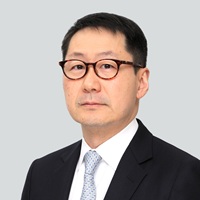For investors looking for growth opportunities offshore, June-Yon Kim (Lazard Asset Management) and Justin Lannen (Maple-Brown Abbott) recommend they look outside the Magnificent Seven and other well known names.
Despite the strong attraction by Australian investors for local companies, there is the undeniable fact that many portfolios are dominated by the big four banks and miners.
For Jason Petras — Director, Investments at Resonant Asset Management — the underperformance of the ASX 200 can be attributed to the relative concentration of the local market in just a handful of stocks — financials and materials — which dominate the Australian share market.
Not surprisingly, there is a compelling argument for investors to look outside Australia for the growth side of their portfolio. This is particularly the case when you consider valuations in the ASX 200 being stretched and earnings per share declining by 16.6 per cent since mid-2022, while the MSCI World Index has recorded strong growth over the same period.

By Jayson Forrest
Jason Petras
Resonant Asset Management.

June-Yon Kim
Lazard Asset Management

Justin Lannen, CFA
Maple-Brown Abbott

With effectively no earnings growth within the financials and materials segments, Jason believes investors should look offshore for growth opportunities, where companies are well-priced and well-positioned to take advantage of global thematics.
As an example, he points to global defence spending, which is beginning to lift as a percentage of GDP. Many western-aligned governments are being ‘encouraged’ by U.S. policy to increase their defence expenditure. As a result of that expenditure, Jason expects to see spending flow through to equity markets.
However, defence spending is only one global thematic, with many other opportunities available to investors across many segments, including Japanese equities and global listed infrastructure.
As an infrastructure investor, we’re seeing no slowdown in the investment required in the infrastructure that society needs. Our job is to find the companies that can capitalise on these mega themes and get a decent rate of return on the money they’re investing
Japanese investment opportunities
Joining Jason at an IMAP webinar on the topic of ‘Opportunities in global markets’, as part of an IMAP Specialist Webinar Series on ‘Growth outside of Australia’, June-Yon Kim — Head of the Japanese Equity Team and a Lead Portfolio Manager/Analyst at Lazard Asset Management — remains bullish on Japanese equities. He says not only is Japan one of the largest developed markets, it is also an extremely broad and diversified market, which provides investors with stock picking opportunities.
In making the case for Japanese equities, June-Yon says historically, Japan has had a relatively low correlation to other developed markets. He acknowledges that while at its peak in 1990, Japan traded at 4x the valuation of the rest of the world (Japan at 60x and the rest of the world at 15x), those valuations are now at all time lows.
“If you focus on the EBITDA number, this is where you find the real opportunity in Japan. Japan has over-capitalised, so at an EBITDA perspective of 6.5x, Japan is currently the cheapest market in the world,” says June-Yon.
“What’s interesting about Japan is there has been plenty of earnings growth. However, when investors talk about earnings, they don’ think of Japan. Instead, when people think about Japan, they think of GDP. But, it’s important to note that when you buy a country, you’re not buying a slice of GDP, you’re buying a slice of earnings.”
According to June-Yon, Japanese stocks have performed well over the last 10 years. He says Japanese companies have been able to deliver positive earnings growth, with earnings significantly better than Europe and Asia (ex Japan), and very similar to the United States. He attributes this to Japanese companies moving in the right direction by pushing down their over-capitalisation.
If you focus on the EBITDA number, this is where you find the real opportunity in Japan. Japan has over-capitalised, so at an EBITDA perspective of 6.5x, Japan is currently the cheapest market in the world
Deflation to inflation
Another factor that strengthens the case for Japanese equities is the fact that its economy is moving away from a deflationary environment to inflation, which June-Yon believes is misunderstood by many foreign investors.
He explains: “In a deflationary environment, the choices that Japanese companies and Japanese investors have made makes a lot of sense. But what we’re now seeing is a return to inflation, which is a positive. Seeing nominal growth is good for earnings and growth, which is being driven by ‘demand-pull’ (upward pressure on prices created by a shortage in supply), as wages growth drives inflation.
“What this is leading to are changes, like a change in corporate mindset, as capex picks up, and also in household spending behaviour. In a deflationary environment, it makes perfect sense to hoard cash, because the value of your money is being maintained. However, as inflation picks up, we’re seeing Japanese consumers slowly getting rid of that cash and moving into risk assets.”
June-Yon believes as the economic framework in Japan changes, the outlook for Japan looks more attractive, which provides investors with genuine opportunities.
“As earnings continue to grow and Japanese companies regain their pricing power, over the next 5-10 years, we’re likely to see one of the most attractive earnings per share profiles for a developed market,” he says. “This is why Japan is such an interesting country from both a beta and alpha perspective.”
Today, there are different ways we can generate electricity — from coal and gas, through to nuclear, solar and wind. However, wherever the power comes from, it needs to go through the grid. And if you own the grid, you’re going to benefit from a return on investment. It’s by focusing on these types of companies that we’re able to get our defensive exposure to ongoing uncertainty
Global listed infrastructure
For investors wanting to access growth opportunities outside of Australia, Justin Lannen, CFA — Co-Founder and Portfolio Manager, Global Listed Infrastructure at Maple-Brown Abbott — believes global infrastructure makes a convincing case. He acknowledges that compared to about 20 years ago, where there was a good number of infrastructure companies available on the ASX, there are very few publicly listed companies remaining to invest in. This means if retail investors want to access infrastructure themes — like airports, toll roads, and electric grids — they need to look offshore.
When considering infrastructure, Maple-Brown Abbott looks for physical, monopolistic assets that provide essential services. From these types of strategic positions, Justin says you tend to get very stable (and often inflation-linked) cashflows and predictable growth.
“Infrastructure is a defensive, low volatility asset class, and it’s a particularly valuable asset when equity markets sell-off or a new market risk emerges,” says Justin. “Infrastructure provides a portfolio with genuine diversification.”
Justin believes for investors seeking growth, the most interesting aspect of infrastructure is the ability to invest in mega themes. This includes decarbonisation of the energy system, digitalisation, transportation, and water. He says all these themes require considerable long-term investment, with Maple-Brown Abbott expecting a long runway of growth coming from various infrastructure thematics over the coming years.
As earnings continue to grow and Japanese companies regain their pricing power, over the next 5-10 years, we’re likely to see one of the most attractive earnings per share profiles for a developed market. This is why Japan is such an interesting country from both a beta and alpha perspective
Mega theme opportunities
When looking at thematic opportunities, Maple-Brown Abbott is invested in developed markets, including North America, Europe and the United Kingdom. It takes a high conviction approach to its Global Listed Infrastructure Fund, which currently consists of 30 stocks.
Some of the big themes for Maple-Brown Abbott across all its invested regions include cell towers, which has significant growth. In addition, it also likes electric utilities in North America, comprising about one-third of the portfolio. These electric utilities are mostly power grid assets, which are required for energy transition, as well as providing electricity and grid infrastructure for data centres.
“As a theme, we like the electric load growth in the United States,” says Justin. “There has basically been no electricity demand growth for over 20 years. But we think that is picking up from 0-1 per cent to around 3 per cent per annum, which requires a lot of investment in electric utilities, particularly in the power grids to service that growth.”
In the U.K., the focus is also on power grids, as well as water assets, while in Europe, Maple-Brown Abbott finds most of its value in airports and toll roads.
“As an infrastructure investor, we’re seeing no slowdown in the investment required in the infrastructure that society needs. Our job is to find the companies that can capitalise on these mega themes and get a decent rate of return on the money they’re investing.”
In order to achieve policy objectives and improvements to living standards that governments want and people demand, investment into infrastructure is needed, but governments simply don’t have the money available to do this on their own. This means the private sector will increasingly be called upon to fund infrastructure
Energy transition
Similar to Australia, where the energy transition to renewables is heavily underwritten by the Government (through subsidies and funding), Justin says governments in offshore developed markets are also heavily invested in this mega theme.
“Government policy in the U.K. and Europe is very supportive for investments in renewable energy, particularly in terms of energy security, following Russia’s invasion of Ukraine and Europe’s reliance on Russian gas.
“We’re seeing huge investments in energy transition, both in the U.K. and Europe, but we do prefer the U.K. because the returns are higher. The energy transition growth rate is huge, particularly into the power grids, like transmission and distribution lines.”
In terms of the U.S., Justin says Maple-Brown Abbott watches the energy transition market closely, particularly in relation to local regulation and politics.
“Since Trump regained office, some of the renewable energy developers have had trouble with government policy. For example, offshore wind projects — which we don’t have exposure to — have been hit hard with project cancellations and pausing. However, as a lot of regulation in the U.S. occurs at a state level, there are still many renewable projects happening, which provide investors with opportunities.”
According to June-Yon, in 2020, Japan committed to net zero by 2050. He believes Japan should have been in a better position for energy transition, given the fact it had a larger part of its fuel mix coming from nuclear, but this changed following the Fukushima nuclear accident in 2011.
Prior to the Fukushima accident, approximately 30 per cent of Japan’s energy mix was driven by nuclear, but that has since dropped to about 7 per cent, says June-Yon. However, he adds Japan’s goal is to get that percentage back up to about 20 per cent by 2030.
“I believe that for Japan to achieve net zero, it needs to have a larger part of its energy mix driven by nuclear. So, I think the percentage of nuclear in the energy mix will probably continue to go up over time. In fact, Kansai Electric Power Company (KEPCO) recently announced it was going to commence a study for a next-generation nuclear reactor at Mihama. And while Fukushima is still a sensitive topic in Japan, the Japanese realise they need to re-embrace nuclear power going forward.”
In terms of portfolio construction, Justin acknowledges it can be challenging making allocations into infrastructure assets, given the long-term nature of projects (particularly in relation to ESG), which is often underpinned by fluid government policy and regulation.
He views any changes in regulation as a business risk, especially in relation to utilities. “We are very focused on potential changes in policy that might impact different sectors and the companies operating in these areas. That’s why we look for physical, monopolistic assets that provide essential services.
“Today, there are different ways we can generate electricity — from coal and gas, through to nuclear, solar and wind. However, wherever the power comes from, it needs to go through the grid. And if you own the grid, you’re going to benefit from a return on investment. It’s by focusing on these types of companies that we’re able to get our defensive exposure to ongoing uncertainty.”
The investment of infrastructure companies is a big secular theme amongst those mega trends. So, moving forward, I believe continued investment in infrastructure will provide investors with the growth and returns they’re looking for in their portfolios
Secular themes driving long-term growth
Looking forward over the next 10 years, June-Yon believes a definite secular theme he is confident will drive long-term returns in portfolios is the trend that Japan is normalising, by returning back to an inflationary environment.
“This means we can expect to see a change in behaviour by Japanese consumers in their consumption habits, rather than deferring consumption. We will also see a change in how both companies and consumers choose to invest. For corporations, this means companies will no longer be price takers, they will be price setters.”
June-Yon says this trend is very positive for Japan. Under this changing environment, he advises investors to look at Japanese companies in a different framework, which includes a company’s ability to ‘raise price’ (increase the cost of goods or services to improve profit margins, and recover increased costs) and to more efficiently allocate capital in an inflationary environment.
And what about global listed infrastructure?
The key long-term trend for Justin is the absolute need for more infrastructure. He says the world is short of the infrastructure it needs, meaning that investment has to take place across many different sectors — like electricity, decarbonisation, artificial intelligence, water, transport, and digitalisation.
“All these themes are long-term,” says Justin. “In order to achieve policy objectives and improvements to living standards that governments want and people demand, investment into infrastructure is needed, but governments simply don’t have the money available to do this on their own. This means the private sector will increasingly be called upon to fund infrastructure.
“The investment of infrastructure companies is a big secular theme amongst those mega trends. So, moving forward, I believe continued investment in infrastructure will provide investors with the growth and returns they’re looking for in their portfolios.”
About
June-Yon Kim is Head of the Japanese Equity Team and a Lead Portfolio Manager/Analyst at Lazard Asset Management; and
Justin Lannen, CFA is Co-Founder & Portfolio Manager, Global Listed Infrastructure at Maple-Brown Abbott.
They spoke on the topic of ‘Opportunities in global markets’ at an IMAP Specialist Webinar Series on ‘Growth outside of Australia’.
The session was moderated by Jason Petras — Director, Investments at Resonant Asset Management.

